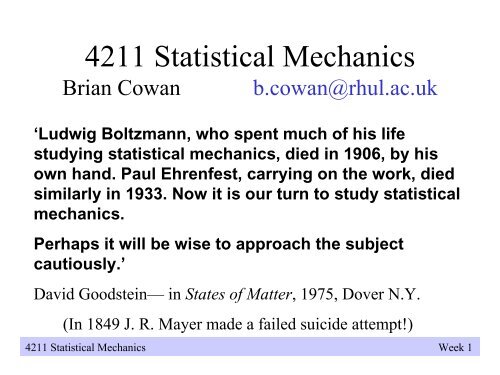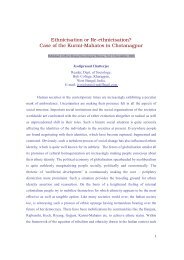4211 Statistical Mechanics - WebRing
4211 Statistical Mechanics - WebRing
4211 Statistical Mechanics - WebRing
You also want an ePaper? Increase the reach of your titles
YUMPU automatically turns print PDFs into web optimized ePapers that Google loves.
<strong>4211</strong> <strong>Statistical</strong> <strong>Mechanics</strong><br />
Brian Cowan b.cowan@rhul.ac.uk<br />
‘Ludwig Boltzmann, who spent much of his life<br />
studying statistical mechanics, died in 1906, by his<br />
own hand. Paul Ehrenfest, carrying on the work, died<br />
similarly in 1933. Now it is our turn to study statistical<br />
mechanics.<br />
Perhaps it will be wise to approach the subject<br />
cautiously.’<br />
David Goodstein— in States of Matter, 1975, Dover N.Y.<br />
(In 1849 J. R. Mayer made a failed suicide attempt!)<br />
<strong>4211</strong> <strong>Statistical</strong> <strong>Mechanics</strong> Week 1
This is a ‘paperless course’<br />
See course web pages for:<br />
<strong>Statistical</strong> <strong>Mechanics</strong><br />
• Course details – syllabus etc.<br />
• Lecture timetable / calendar<br />
• Lecture notes<br />
• Problem sheets<br />
• Other useful information<br />
• Past exam papers<br />
http://personal.rhul.ac.uk/UHAP/027/PH<strong>4211</strong>/<br />
<strong>4211</strong> <strong>Statistical</strong> <strong>Mechanics</strong> Week 1
Course Outline<br />
• Methodology of <strong>Statistical</strong> <strong>Mechanics</strong><br />
• Non-Ideal Gases<br />
• Phase Transitions<br />
• Fluctuations and Dynamics<br />
This year’s Special Topic:<br />
The Higgs Mechanism<br />
<strong>4211</strong> <strong>Statistical</strong> <strong>Mechanics</strong> Week 1
Chapter 1<br />
The Methodology of <strong>Statistical</strong> <strong>Mechanics</strong><br />
1.1 Terminology and Methodology<br />
1.1.1 Approaches to the subject<br />
Thermodynamics is the study of the relationship between<br />
macroscopic properties of systems, such as temperature, volume,<br />
pressure, magnetisation, compressibility etc. etc.<br />
<strong>Statistical</strong> <strong>Mechanics</strong> is concerned with understanding how the<br />
various macroscopic properties arise as a consequence of the<br />
microscopic nature of the system. In essence it makes<br />
macroscopic deductions from microscopic models.<br />
<strong>4211</strong> <strong>Statistical</strong> <strong>Mechanics</strong> Week 1
Albert Einstein…….<br />
‘A theory is the more impressive the greater the<br />
simplicity of its premises is, the more different kinds of<br />
things it relates, and the more extended is its area of<br />
applicability.<br />
Therefore the deep impression which classical<br />
thermodynamics made upon me; it is the only physical<br />
theory of universal content concerning which I am<br />
convinced that, within the framework of the applicability<br />
of its basic concepts, will never be overthrown.’<br />
Autobiographical Notes, Albert Einstein: Philosopher-Scientist,<br />
Ed. P. A. Schilpp, Open Court Publishing Co. 1949<br />
<strong>4211</strong> <strong>Statistical</strong> <strong>Mechanics</strong> Week 1
Lev Landau…..<br />
‘<strong>Statistical</strong> physics and thermodynamics together form<br />
a unit.<br />
All the concepts and quantities of thermodynamics<br />
follow most naturally, simply and rigorously from the<br />
concepts of statistical physics.<br />
Although the general statements of thermodynamics<br />
can be formulated non-statistically, their application to<br />
specific cases always requires the use of statistical<br />
physics.’<br />
In the Preface to <strong>Statistical</strong> Physics, vol 5 of Landau and Lifshitz<br />
Course of Theoretical Physics.<br />
<strong>4211</strong> <strong>Statistical</strong> <strong>Mechanics</strong> Week 1
1.1.2 Description of states<br />
Macrostate<br />
Microstate<br />
<strong>4211</strong> <strong>Statistical</strong> <strong>Mechanics</strong> Week 1
1.1.3 Extensivity and the Thermodynamic Limit<br />
• Extensive variables<br />
• Intensive variables<br />
Stat. Mech. deals with large systems – thermodynamic limit:<br />
N → ∞, V → ∞, while N/V remains constant.<br />
Surface effects can be neglected – Short-range forces!<br />
<strong>4211</strong> <strong>Statistical</strong> <strong>Mechanics</strong> Week 1
1.2 The Fundamental Principles<br />
<strong>4211</strong> <strong>Statistical</strong> <strong>Mechanics</strong> Week 1
1.2.1 The laws of thermodynamics<br />
• Zeroth Law<br />
•First Law<br />
• Second Law<br />
• Third Law<br />
<strong>4211</strong> <strong>Statistical</strong> <strong>Mechanics</strong> Week 1
Zeroth Law<br />
If system A is in equilibrium with system B and with system C<br />
then system B is in equilibrium with system C.<br />
• The existence of equilibrium states<br />
<strong>4211</strong> <strong>Statistical</strong> <strong>Mechanics</strong> Week 1
First Law<br />
The internal energy of a body can change by the flow of heat<br />
or by doing work.<br />
Δ E =Δ Q+ΔW Beware different sign conventions for ΔW.<br />
<strong>4211</strong> <strong>Statistical</strong> <strong>Mechanics</strong> Week 1
Second Law<br />
Clausius: Heat flows from hot to cold.<br />
Kelvin: It is not possible to convert all heat energy to<br />
work.<br />
Carathéodory: In the neighbourhood of any equilibrium state<br />
of a thermally isolated system there are states<br />
which are inaccessible.<br />
Callen: There is an extensive quantity, which we call<br />
entropy, which never decreases in a physical<br />
process.<br />
<strong>4211</strong> <strong>Statistical</strong> <strong>Mechanics</strong> Week 1
Nernst, Simon and others<br />
Third Law<br />
The entropy of a body tends to zero as the temperature tends<br />
to absolute zero.<br />
<strong>4211</strong> <strong>Statistical</strong> <strong>Mechanics</strong> Week 1
1.2.2 Probabilistic interpretation of the First Law<br />
E = ∑ PE<br />
j<br />
<strong>4211</strong> <strong>Statistical</strong> <strong>Mechanics</strong> 15 Week 1<br />
j j<br />
∑ ∑<br />
dE= P dE + E dP<br />
j j j j<br />
j j<br />
∑ ∑<br />
P dE = dW E dP = dQ<br />
j j j j<br />
j j<br />
Shifting energy levels Changing populations of states<br />
Work Heat
1.2.3 Microscopic basis for entropy<br />
Postulate – All microstates of an isolated system are<br />
equally likely. Isolated system specified by E, V, N.<br />
( EV , , N)<br />
Ω is number of microstates in macrostate (E, V, N)<br />
( , , ) ∝Ω(<br />
, , )<br />
P EV N EV N<br />
Ω is multiplicative, so lnΩ is additive – extensive variable<br />
So define entropy S:<br />
( , , ) = ln Ω(<br />
, , )<br />
S E V N k E V N<br />
<strong>4211</strong> <strong>Statistical</strong> <strong>Mechanics</strong> Week 1
Ludwig Boltzmann<br />
1844 - 1902<br />
<strong>4211</strong> <strong>Statistical</strong> <strong>Mechanics</strong> Week 1
1.3 Interactions – The conditions for Equilibrium<br />
When systems interact their states will often change, the<br />
composite system evolving to a state of equilibrium. We shall<br />
investigate what determines the final state. We will see that<br />
quantities such as temperature emerge in the description of these<br />
equilibrium states.<br />
<strong>4211</strong> <strong>Statistical</strong> <strong>Mechanics</strong> Week 1
1.3.1 Thermal interaction – Temperature<br />
E 1 V 1 N 1 E 2 V 2 N 2 E 1 V 1 N 1 E 2 V 2 N 2<br />
fixed diathermal wall<br />
<strong>4211</strong> <strong>Statistical</strong> <strong>Mechanics</strong> Week 1
1.3.1 Thermal interaction – Temperature<br />
E 1 and E 2 can vary subject to E 1 + E 2 = const = E 0.<br />
( E ) ( E )<br />
Ω=Ω Ω<br />
1 1 2 2<br />
( E) ( E E)<br />
Ω =Ω Ω −<br />
1 2 0<br />
Maximise Ω subject to varying E.<br />
dΩ<br />
dΩ1 dΩ2<br />
= Ω2 −Ω 1 = 0<br />
dE dE dE<br />
1 dΩ1 dΩ<br />
=<br />
Ω dE Ω dE<br />
1 2<br />
1 2<br />
dlnΩ1 dlnΩ2 dS1 dS2<br />
= or =<br />
dE dE dE dE<br />
<strong>4211</strong> <strong>Statistical</strong> <strong>Mechanics</strong> Week 1
1.3.2 Volume change – Pressure<br />
E 1 V 1 N 1 E 2 V 2 N 2 E 1 V 1 N 1 E 2 V 2 N 2<br />
movable diathermal wall<br />
<strong>4211</strong> <strong>Statistical</strong> <strong>Mechanics</strong> Week 1
1.3.3 Particle interchange – chemical potential.<br />
E 1 V 1 N 1 E 2 V 2 N 2 E 1 V 1 N 1 E 2 V 2 N 2<br />
fixed permeable diathermal wall<br />
<strong>4211</strong> <strong>Statistical</strong> <strong>Mechanics</strong> Week 1
1.3.4 Thermal interaction with the rest of the world – The<br />
Boltzmann factor<br />
The Canonical Distribution Function<br />
fixed diathermal wall<br />
Ω B<br />
heat bath<br />
Ω<br />
system of interest<br />
energy E<br />
total energy E T<br />
<strong>4211</strong> <strong>Statistical</strong> <strong>Mechanics</strong> Week 1
1.3.4 Thermal interaction with the rest of the world – The<br />
Boltzmann factor<br />
The Canonical Distribution Function<br />
E kT<br />
P( E) e −<br />
∝<br />
The Boltzmann factor is a key result. Richard Feynman says:<br />
“This fundamental law is the summit of statistical<br />
mechanics, and the entire subject is either a slidedown<br />
from the summit, as the principle is applied to<br />
various cases, or the climb-up to where the<br />
fundamental law is derived and the concepts of<br />
thermal equilibrium and temperature clarified”.<br />
R. P. Feynman, <strong>Statistical</strong> <strong>Mechanics</strong>, Benjamin 1972.<br />
<strong>4211</strong> <strong>Statistical</strong> <strong>Mechanics</strong> Week 1
1.3.5 Particle and energy exchange with the rest of the world<br />
– the Gibbs factor<br />
The Grand Canonical Distribution Function<br />
fixed diathermal<br />
permeable wall<br />
Ω B<br />
heat bath<br />
Ω<br />
system of interest<br />
energy E<br />
particles N<br />
total energy ET total particles NT <strong>4211</strong> <strong>Statistical</strong> <strong>Mechanics</strong> Week 1
1.4 Thermodynamic averages<br />
1.4.1 The partition function<br />
E kT<br />
P( E) e −<br />
∝<br />
e<br />
P( E)<br />
=<br />
Z<br />
Z = ∑e<br />
−EkT<br />
j<br />
−E<br />
kT<br />
Z is the partition function – amazingly important!<br />
<strong>4211</strong> <strong>Statistical</strong> <strong>Mechanics</strong> Week 1<br />
j
1.4.2 Generalised expression for Entropy<br />
collection of identical systems<br />
system of interest<br />
S =−k<br />
P ln P<br />
j j<br />
=−k<br />
ln P .<br />
<strong>4211</strong> <strong>Statistical</strong> <strong>Mechanics</strong> Week 1<br />
∑<br />
j<br />
j
1.4.3 Free Energy<br />
( , )<br />
−E<br />
N V kT<br />
j e<br />
P( , , )<br />
, ( , , )<br />
j NVT = Z NVT = ∑e<br />
Z N, V, T<br />
( )<br />
⎛Ej⎞ ln Pj=− ⎜ + ln Z⎟<br />
⎝kT ⎠<br />
Ej<br />
S= k + ln Z<br />
kT<br />
E<br />
S= + kln Z<br />
T<br />
E− TS=−kTln Z<br />
F= E− TS F=−kTln Z<br />
( , )<br />
−E<br />
N V kT<br />
<strong>4211</strong> <strong>Statistical</strong> <strong>Mechanics</strong> Week 1<br />
j<br />
j
1.4.4 Thermodynamic Variables<br />
A host of thermodynamic variables can be obtained from the<br />
partition function. This is seen from the differential of the free<br />
energy.<br />
dE= TdS− pdV+ μdN<br />
but F= E−TS so that dF=−SdT− pdV+ μdN<br />
Then we can identify the partial derivatives:<br />
<strong>4211</strong> <strong>Statistical</strong> <strong>Mechanics</strong> Week 1
1.4.4 Thermodynamic Variables<br />
dF= −SdT− pdV+ μdN<br />
∂F ∂ln<br />
Z<br />
so that S=− = kT + klnZ ∂T ∂T<br />
and then<br />
VN , VN ,<br />
∂F ∂ln<br />
Z<br />
p=− = kT<br />
∂V ∂V<br />
TN , TN ,<br />
∂F ∂ln<br />
Z<br />
μ = =−kT<br />
∂N ∂N<br />
TV , TV ,<br />
E= F+ TS= kT<br />
So all follows from differentiating Z.<br />
<strong>4211</strong> <strong>Statistical</strong> <strong>Mechanics</strong> Week 1<br />
2<br />
∂ln<br />
Z<br />
∂T<br />
VN ,
















